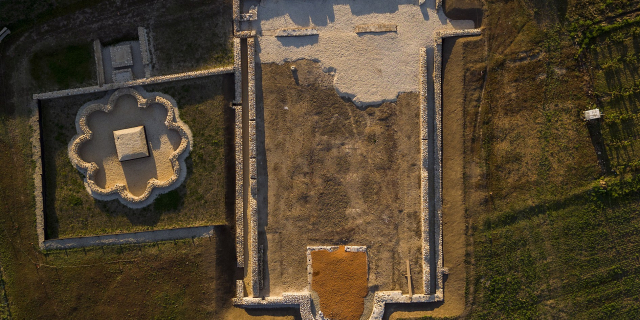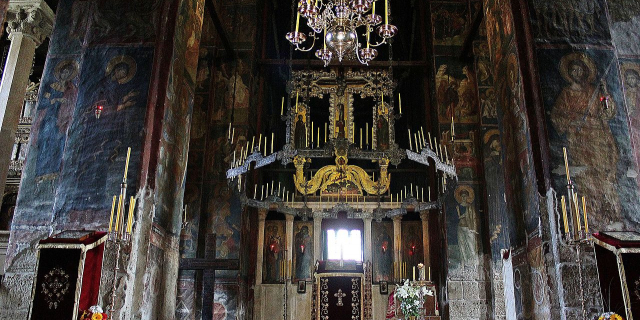Gračanica Monastery
The Gračanica Monastery (Serbian: Манастир Грачаница, romanized: Manastir Gračanica, pronounced [ɡratʃǎnitsa]; Albanian: Manastiri i Graçanicës) is a Serbian Orthodox monastery located in Kosovo. It was built by the Serbian king Stefan Milutin in 1321. The monastery was declared a Monument of Culture of Exceptional Importance in 1990, and on 13 July 2006 it was placed on UNESCO's World Heritage List under the name of Medieval Monuments in Kosovo as an extension of the Visoki Dečani site, which was overall placed on the List of World Heritage in Danger.
The Gračanica Monastery is one of King Milutin's last monumental endowments. The monastery is located in Gračanica, a Serbian enclave in the close vicinity of Lipjan, the old residence of bishops of Lipljan.
 ktetor (founder) fresco with Stefan Milutin holding a model of the church, ca. 1321.
ktetor (founder) fresco with Stefan Milutin holding a model of the church, ca. 1321.Gračanica was constructed on the ruins of an older 13th-century church of the Holy Virgin. It was located in the centre of the Eparchy of Lipljan. Stefan Milutin's ktetor comment are written on the southern wall, including "I have seen the ruins and the decay of the Holy Virgin's temple of Gračanica, the bishopric of Lipljan, so I have built it from the ground and painted and decorated it both from inside and outside". In 1346, when the Serbian Archbishopric was raised to the rank of Patriarchate, the bishop of Lipljan was granted the honorary title of metropolitan bishop, and since that time they were called metropolitans of Lipljan or Gračanica.
Of the former monastic compound, only the church has survived. The narthex and the tower were added a few decades later, in order to protect the frescoes on the west facade. The narthex was heavily damaged by the Ottomans several times between 1379–1383, when the tower was burned and a fire devoured a rich collection of manuscripts and other precious objects. The narthex was reconstructed in 1383. Again, Gračanica suffered damages at the time of the Battle of Kosovo (1389).
During Ottoman rule Gračanica became an important cultural center. In the time of Metropolitan Nikanor (1528–1555) several icons were painted on the altarpiece. Also, because of the printing press, Nikanor obtained numerous service books and objects for monastic use. The royal doors were commissioned in 1564 by Metropolitan Dionisije, whose death is represented on a fresco in the narthex. Major restoration took place through efforts of Patriarch Makarije Sokolović. All the openings on the external narthex were walled up and new frescoes were completed in 1570. Thanks to Patriarch Pajsije, the church got its leaden roofing, and in 1620 the large cross with crucifix was made on the iconostasis. The monastery was exposed to new damages toward the end of the 17th century, in the Great Turkish War, after the second siege of Vienna - in which the Serbs took part on the Christian side. Turks removed the leaden cross and pulled out the floor tiles, together with the treasure hidden in the church by Patriarch Arsenije III.
After the World War II it was renewed by nuns and has been serving as a convent since. Today there are 24 sisters in the monastery who are active in icon painting, agriculture, sewing and other monastic obediences.
In 1999 the monastery was bombed twice by NATO airplanes.[1] After the Kosovo War (1998–99), Bishop of Raška and Prizren Artemije Radosavljević transferred his official seat to this monastery from Prizren and since then the monastery has become not only the most important spiritual but also the national and political center of the Serb community in Kosovo.
The monastery was declared a Monument of Culture of Exceptional Importance in 1990, and on 13 July 2006 it was placed on UNESCO's World Heritage List under the name of Medieval Monuments in Kosovo as an extension of the Visoki Dečani site which was overall placed on the List of World Heritage in Danger.[2][3]
































Add new comment